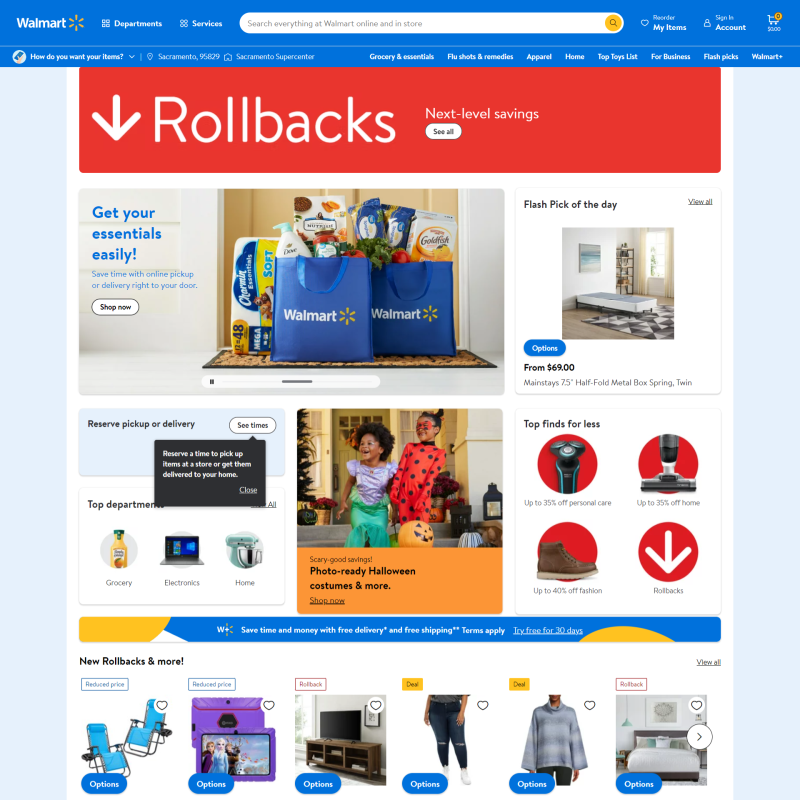Whether you're buying presents for someone else or a treat for yourself, where you get your items matters. It's not just about the price, packaging, and shipping time, though. You also need to make sure you can return any items that don't work for you, come in damaged, or you just don't like. Fast, efficient, easy returns are important for customers, and understanding return policies matters.
Table of content
- Return Policies Overview
- Pros and Cons
- Comparative Table
- Common FAQ
- Can I return something I bought from Amazon to Walmart or Target?
- What are Amazon's advantages over Walmart and Target in terms of returns?
- Which stores offer Returnless Refunds?
- Do I need a receipt to return items at Target, Walmart, or Amazon?
- Conclusion: Which Return Policy Is Best for You?
So, what's best? Should you compare Amazon vs. Walmart returns or focus on the Target return policy? We can tel you everything you need to know about retailer comparison returns. With some extra knowledge of policies for Amazon, Walmart, and Target, you can find the winning retailer for all your purchases.
Return Policies Overview
The first stop on your journey to choosing the retailer with the best return policy is a comparison. After all, some parts of the policy might be more important to you than others, so you want to see right away if a specific retailer stands out. Here's an overview of the policies of Amazon, Walmart, and Target, so you can narrow down your shopping choices.
Amazon

Amazon has a 30-day policy for the majority of its returns, but there are some exceptions. Digital products, hazardous materials, gift cards, and final sale/bulk merchandise items aren't eligible for return.
When you need to send something back to Amazon you can take it to a physical store that partners with the company. These stores include Kohl's, Whole Foods, and UPS stores. Keep in mind, though, that doesn't mean every one of these stores' locations take Amazon returns, so you'll want to use Amazon's return drop-off locator to find an option near you.
There are a few unique features when you need to return something to Amazon. For example, the length of time you have to return something during the holiday season is longer, because the company knows you may be ordering a little ahead of time and giving the item as a gift. Generally, anything purchased after November1st can be returned through January 31st.

There are also some products that qualify for returnless refunds, because the cost of shipping it back may be more than the cost of the item. These refunds are also sometimes given for something that might be unsafe or risky to resell, such as medications or single-use products.
Walmart

Comparing Amazon vs. Walmart returns will show you that the retailers are similar in a lot of ways, but at 90 days, Walmart has a longer return policy on most items. Some holiday items even extend past 90 days to allow for the return of gifts that just didn't work, didn't come in on time, or were damaged.
In-store returns can be processed with a receipt or the credit card you used for purchase, since the store can look up the item using your payment method and see when it was purchased. Online purchases are saved in your Walmart account and can be handled by initiating a return from Walmart's website.

If you made a purchase through Walmart online and want to return it at your local store you can do that in most cases. With Walmart's Returns Portal you can return your item in the store or by mail. Initiating a return is quick and easy, and you'll be ready to have your return processed in just a few clicks. There are some restrictions to the return policy, though, such as electronics, perishable goods, or seasonal items.
Target

The Target return policy is similar to what's offered by Walmart and Amazon, but they have a 90-day return window. This is longer than the other two retailers, giving you more time to decide if you like something or give it as a gift. Keep in mind, though, that items need to be unopened and in new condition for the return window to be honored. If you have the Target RedCard you have an extended return window of 120 days.

If you bought through Target online and want to return the item to your local store you can do that, but you'll need a return barcode and a valid receipt. You can get these through the website or app.
Use the toggle at the top of your account page to go to Online, then Orders (on the website) or Purchases (in the app). Then, select Return and follow the prompts to get a barcode and receipt. Take your item, receipt, barcode, and payment method to your closest Target store and go to Guest Services to complete the return.
There are some exclusions to the standard Target return policy including opened cosmetics, electronics, and heavy items that were delivered to your home by a freight carrier.
Pros and Cons

Every retailer has strengths and weaknesses to their return policy. With Amazon vs. Walmart returns and the Target return policy, the biggest pros and cons are worth considering, so you can choose the retailer that best fits your needs.
Amazon
- Easy and convenient
- Best for flexibility
- Multiple drop-off locations
- Returnless refunds in some cases
- No dedicated in-store option
- Short, 30-day return window
Walmart
- Long, 90-day return window for general merchandise
- Return online purchases in the store
- Curbside pickup for returnsReturnless refunds in some cases
- Short window for appliances, Marketplace items, and more
- Up to 10 business days for credit card refund
- Up to 7 business days for debit card refund
Target
- Long, 90-day return window on most products
- Longer, 120-day return window for RedCard members
- Return online purchases in the store
- No returns through third-party delivery service
- Holiday and limited-time-only collections have limited return windows
- No international returns or exchanges
Comparative Table
Here are the key features of the Target return policy, along with a comparison of Amazon vs. Walmart returns and the policies and exceptions that affect them. The at-a-glance information helps with retailer comparison returns.
| Feature | Amazon | Walmart | Target |
| Return Window | 30 days (varies by item) | 90 days | 90 days (120 w/ RedCard) |
| Return Methods | Mail, Kohl’s, Whole Foods, UPS Store | In-store, mail, curbside pickup | In-store, mail |
| Return Fees | Free for most items | Free for most items | Free for most items |
| Returnless Refunds | Yes | Yes | Yes |
| Gift Returns | Yes, with gift receipt | Yes, with gift receipt | Yes, with gift receipt |
| Receipt Requirements | Flexible (via account) | Receipt or account info | Receipt or account info |
| Holiday Extensions | Yes, through January | Yes, through January | Yes, through January |
| Main Exclusions | Non-returnable items | Electronics, perishables | Opened cosmetics, electronics |
| Customer Support | 24/7 chat support | Phone and in-store help | Phone and in-store help |
Common FAQ

Even if you look through the Target return policy and compare Amazon vs. Walmart returns you may still have some questions. Here are a few of the most common ones, so you can feel confident when you place an order, knowing you can return it conveniently if you need to.
Can I return something I bought from Amazon to Walmart or Target?
Typically, no. Because Amazon, Walmart, and Target are separate companies you can't return something you bought at one company to another one. There are third-party services and return-by-mail options for Amazon returns, though, along with return-by-mail opportunities for Target and Walmart, to make returns easy even if you don't live close to a brick-and-mortar location.
What are Amazon's advantages over Walmart and Target in terms of returns?
Amazon is typically easier for returns because they'll take back almost anything as long as it's within the return window. They have extended holiday return windows, and multiple shipping partners where you can drop off a return for processing. Because they partner with other companies customers have plenty of places they can take an item they want to return, and they aren't limited to online mail or in-store processing.

Which stores offer Returnless Refunds?
Amazon, Walmart, and Target all offer returnless refunds, which is something to remember when you're considering retailer comparison returns. There are also other retailers who offer returnless refunds, although not as frequently as these three retail giants.
Do I need a receipt to return items at Target, Walmart, or Amazon?
While it's easier to return items with a receipt, you can also return most purchases for store credit at all three retailers. When you order online there's a record of your purchase, so the retailer can verify that the purchase came from your account when it was purchased, and the payment method that was used.

Conclusion: Which Return Policy Is Best for You?
The return policy that works for you might not be the same as the policy that works for someone else, so knowing which retailers offer the best return policy for your needs is essential to a better shopping experience. Taking the time to look through policy information and understand the specifics is a vital way to address retailer comparison returns. In short:
- Amazon: Best for convenience, especially for online shoppers who want flexible returns and plenty of drop-off locations through shipping partnerships.
- Walmart: Best for shoppers looking for a broad return window and simplicity, since Walmart stores are everywhere and you can return in-store or online.
- Target: Best for loyal customers with RedCard benefits or those who need in-store flexibility, as Target rewards RedCard members have longer return windows and other perks.
Which retailer has made returns easiest for you? Share your experience in the comments and let us know!
The responses below are not provided, commissioned, reviewed, approved, or otherwise endorsed by any financial entity or advertiser. It is not the advertiser’s responsibility to ensure all posts and/or questions are answered.







